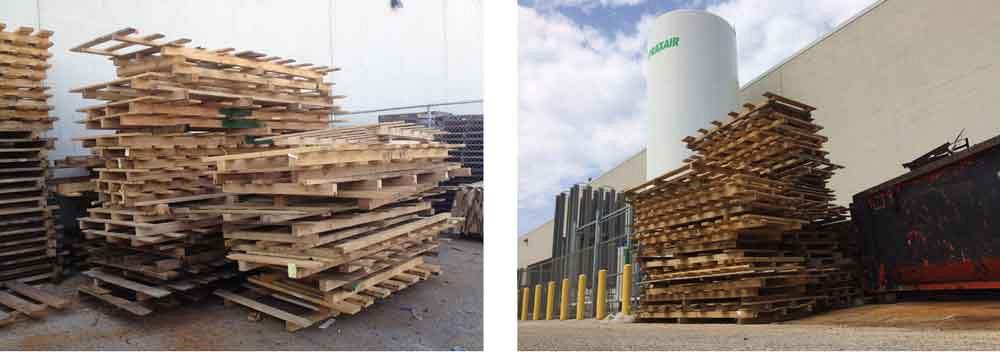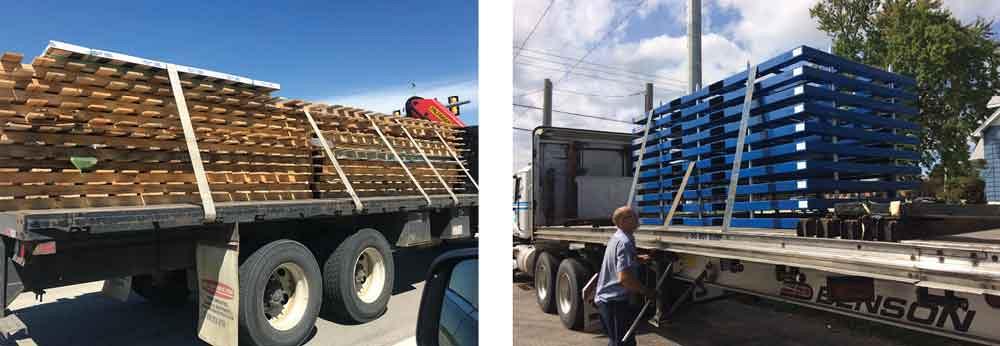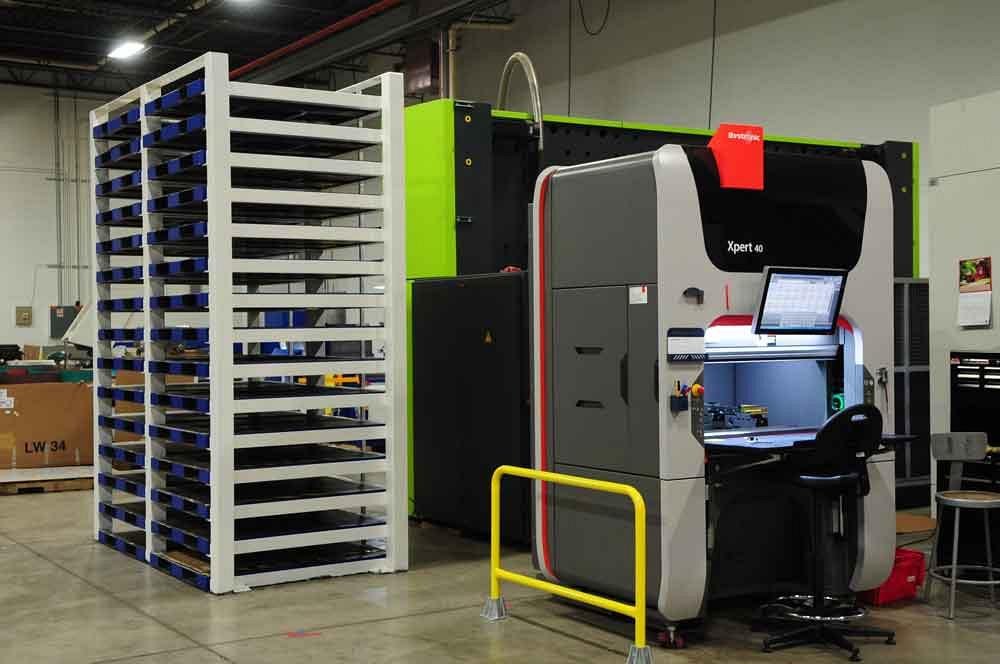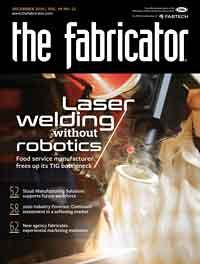Owner
- FMA
- The Fabricator
- FABTECH
- Canadian Metalworking
Categories
- Additive Manufacturing
- Aluminum Welding
- Arc Welding
- Assembly and Joining
- Automation and Robotics
- Bending and Forming
- Consumables
- Cutting and Weld Prep
- Electric Vehicles
- En Español
- Finishing
- Hydroforming
- Laser Cutting
- Laser Welding
- Machining
- Manufacturing Software
- Materials Handling
- Metals/Materials
- Oxyfuel Cutting
- Plasma Cutting
- Power Tools
- Punching and Other Holemaking
- Roll Forming
- Safety
- Sawing
- Shearing
- Shop Management
- Testing and Measuring
- Tube and Pipe Fabrication
- Tube and Pipe Production
- Waterjet Cutting
Industry Directory
Webcasts
Podcasts
FAB 40
Advertise
Subscribe
Account Login
Search
Inventory in the age of fiber laser cutting
The high-volume cutting productivity of fiber lasers has changed the game for fab shops
- By Jake Erschen
- December 19, 2019
- Article
- Laser Cutting

Cutting throughput skyrockets and yet profits don’t. So where does profit end up? Probably in stored material, crammed into every nook and cranny of a fabrication shop.
Replacing a CO2 laser with a new fiber laser can double or triple a shop’s machine capacity nearly overnight. They are beasts, crazy fast, and always hungry for more material. But along with the top-line revenue increase they support, does the bottom line uphold its percentage to validate the return on investment? The typical answer is not as loud of a resounding “yes” as you might expect it to be. This begs the question, where is the profit going?
As shops grow their revenue, there is more of “something” on the floor at any given time, whether it’s in the form of raw material, work-in-process, or finished goods. But more than likely, the shop floor space was already full before the new machinery was even purchased. So where does all the increased volume go?
The short answer: It gets crammed in. Material handlers end up spending many of their working hours burying material into every nook and cranny they can find. With the necessary material somehow crammed into the building, operators then inevitably spend their time (and the company’s potential profit) searching for and then unburying the sheets they need for the next job. It’s not a knock on their performance; in fact, they are likely doing their job the best they can. After all, the company invested in those high-dollar lasers, and now they need to keep the beasts fed, right?
A little longer answer: The crammed material gets damaged, overhandled, or lost, and actually slows the output of the high-dollar equipment. Programmers work around bent corners, banged edges, and scratched surfaces to meet customers’ expectations. And at what expense? Productivity and profitability, which are the very reasons for the large capital investment in the new machine.
In today’s on-demand society, many supply chain purchasers request their key job shops (that is, valued suppliers) to hold various gauges and grades of all the common materials for their product line. From the job shop’s perspective, that on-hand material serves as ammunition to get more sales out the door in less time. Likewise, it’s also a commitment of loyalty between the customer and vendor.
In the past a three- to four-week lead time for laser-cut parts was great, but now everyone needs their order as soon as it’s placed. Of course, lead time for custom fabrication is longer than Amazon’s same-day pull-from-inventory model, but all job shop owners feel the pressure to get creative to meet ever-more-stringent delivery requirements customers now demand.
As more ammunition in the form of raw sheet stock is on-hand, it’s incredibly important for job shops to keep that stock at the ready; it does no good for material to be in-house if it’s not also accessible.
Of course, all of this wasted time, energy, money, and material is avoidable with the right foresight. As the volume of material throughput increases with new machine hours, there are two logical options: increase the building’s square footage or improve the storage density both upstream and downstream.
High Storage Density Presents Options
The second option involves improving storage and material handling methods so the same footprint previously allocated to material storage can efficiently store two to three times the current capacity while also improving accessibility and safety. With new high-density storage systems in place to reduce the company’s inventory footprint, business models can shift, and big decisions can be made.
Freed space gives owners and managers options. Depending on the situation, they might choose to stock more gauges and grades of material for quick-turn orders; or they might choose to fill the freed space with equipment that will open doors to a new market or bring more operations in-house. Depending on the shop’s mix of work and target markets, management teams can make decisions to take their shop to the next level, something that would have been much more difficult to do without proper inventory management.

Figure 1
In the era of the fiber laser, the days are limited for wooden pallets and cantilever racks
Industrial and manufacturing engineers geek-out on reducing cycle times of a robotic welding application by 5 to 10 percent, but what if they were able to take 60 to 70 percent out of material retrieval time?
Problems With Wooden Pallets
For raw sheet metal, conventional wooden skids with pallet racking and cantilever-arm racking cannot efficiently accommodate the fiber laser era’s volume of material without overtaking the whole shop floor (see Figure 1).
Typically, wooden pallets get stacked in front of the racks, material gets damaged, and the material an operator needs for the next job is always too deeply buried to retrieve in time for the laser’s beam to stay on. Further, wooden pallets are notorious for splintering, snapping, and even causing some fabricators to rebuild their whole company from scratch after a pallet fire. As the final sprinkle of salt on the wound, the time and money expensed to moving and disposing of wooden pallets hits the company’s bottom line every single month.
To replace these racks, a shop’s management team might choose to install an automated storage and retrieval system to tame the raw stock chaos, but these systems aren’t the only option. Some manual systems keep material manually accessible within a similarly condensed footprint. Both automated and manual high-density systems can likely fit somewhere between 18 and 22 bundles of material within a single footprint, while keeping every bundle independently accessible. Whether manual or automated, high-density storage systems typically have double or triple the density of conventional racking, which is the perfect balance when considering fiber lasers are now two to three times faster than the previous machines.
Regardless of whether or not a shop floor is QR-coded today, both automated and manual forms of high-density storage are great tools for safeguarding material certs, maintaining accurate sheet counts, and easily managing first-in, first-out lanes. Again, much of this ease relays back to the principle of having all material accessible and centrally located at all times. Whether material is QR-coded, color-coded, or labeled in another way, everyone—managers, supervisors, schedulers, runners, operators—understands exactly where each material is at any given time and how quickly it can be accessed.
The Potential of Returnables
As we begin to define and develop the fiber era, more companies are moving away from single-use wooden pallets and instead implementing returnable systems for raw sheet stock with their valued suppliers. Organizing returnable dunnage has limitations, but the industry-leading service centers are working closely with customers to provide them outside-the-box alternatives that save money above and beyond their competition, thus building strong and loyal partnerships (see Figure 2).
Other industries already have been executing this returnable system for many years, and it’s time the metal fabrication industry joins them. Consider the term “milk run.” It’s a vernacular term, recognizable from the days when milk jugs were hand-delivered to a client’s door. When the milkman dropped off the milk, he picked up the empty jugs and took them back to the processing facility to be refilled. So why are most metal fabricators nearly 100 years behind this model?
By receiving material with the same dunnage every time, consistency is established. Purchasers and industrial engineers can then tailor that consistency to mesh perfectly with internal operations. For example, a fabricator might receive material on the same returnable steel pallets (now called cartridges or cassettes) and then load them directly into high-density storage. Taking principles from any basic kanban system, at the same time of the delivery, the service center loads “empties” on their trailer and takes them back. It’s so simple and effective that it’s a no-brainer for fabricators that have strong, loyal relationships with their suppliers.
Downstream Opportunities
Upstream from the lasers is full of easy wins that can make monumental differences in operations and, ultimately, profits. But upstream isn’t the only opportunity. Downstream opportunities abound as well.
Just as fabricators are now holding two to three times as much raw material, their WIP levels are also growing. And as blanks are coming out of the lasers, they need to be denested and placed en queue for the brakes in an efficient manner (see Figure 3).

Figure 2
Industry-leading service centers work with top customers to improve efficiency in receiving material. On the left are traditional wooden pallets that need to be managed and disposed of. The returnable dunnage on the right eliminates that waste.
Again, conventional racking simply takes too much space and leaves parts buried. But high-density storage, whether automated or manual, allows operators to keep their high-speed press brakes moving up and down. The same concept should be applied to WIP, though there are more variables to consider than with the raw sheet metal.
At a job shop, fabricators might work with either small or large blanks in either small or large volumes, depending on what the sales team is able to win at any given time. To meet OEM demands, job shops might produce large enclosures for a month and then small brackets for two weeks after that. Everyone at job shops must be prepared for a variety of component work.
Regardless of blank size, an organized and accessible staging rack for flat laser-cut blanks can help improve visual management and process flow. If parts for a particular bending cell are staged in the same place, work load is extremely obvious at any given time, and operators always know what’s coming next. This allows them to group setups together since they can see which jobs are lined up for the day.
If operators start an eight-hour shift and see only about four hours’ worth of parts staged at their brake, they can alert a manager with time to react, instead of being in a state of panic when they suddenly realize they’re forming the last batch of parts. Of course, some companies are far more advanced than this in terms of scheduling, but at its roots, visual work load management is very effective.
As a general trend, fabricators are more focused on the upstream right now, as the raw sheet stock is such a visible bottleneck and eyesore. All signs indicate that as more fabricators improve that storage, they will take what they learned from the sheet stock and apply the same principles to downstream operations.
Those principles keep parts flowing, increasing velocity from the receiving dock all the way to the shipping dock. Increase that velocity, and you truly increase capacity by shipping more products in less time—finally revealing those elusive profits.
Jake Erschen is owner of Lean Manufacturing Products Inc.
About the Author
Jake Erschen
262-875-3071
subscribe now

The Fabricator is North America's leading magazine for the metal forming and fabricating industry. The magazine delivers the news, technical articles, and case histories that enable fabricators to do their jobs more efficiently. The Fabricator has served the industry since 1970.
start your free subscription- Stay connected from anywhere

Easily access valuable industry resources now with full access to the digital edition of The Fabricator.

Easily access valuable industry resources now with full access to the digital edition of The Welder.

Easily access valuable industry resources now with full access to the digital edition of The Tube and Pipe Journal.
- Podcasting
- Podcast:
- The Fabricator Podcast
- Published:
- 04/16/2024
- Running Time:
- 63:29
In this episode of The Fabricator Podcast, Caleb Chamberlain, co-founder and CEO of OSH Cut, discusses his company’s...
- Trending Articles
Capturing, recording equipment inspection data for FMEA

Tips for creating sheet metal tubes with perforations

Are two heads better than one in fiber laser cutting?

Supporting the metal fabricating industry through FMA

Hypertherm Associates implements Rapyuta Robotics AMRs in warehouse

- Industry Events
16th Annual Safety Conference
- April 30 - May 1, 2024
- Elgin,
Pipe and Tube Conference
- May 21 - 22, 2024
- Omaha, NE
World-Class Roll Forming Workshop
- June 5 - 6, 2024
- Louisville, KY
Advanced Laser Application Workshop
- June 25 - 27, 2024
- Novi, MI



























